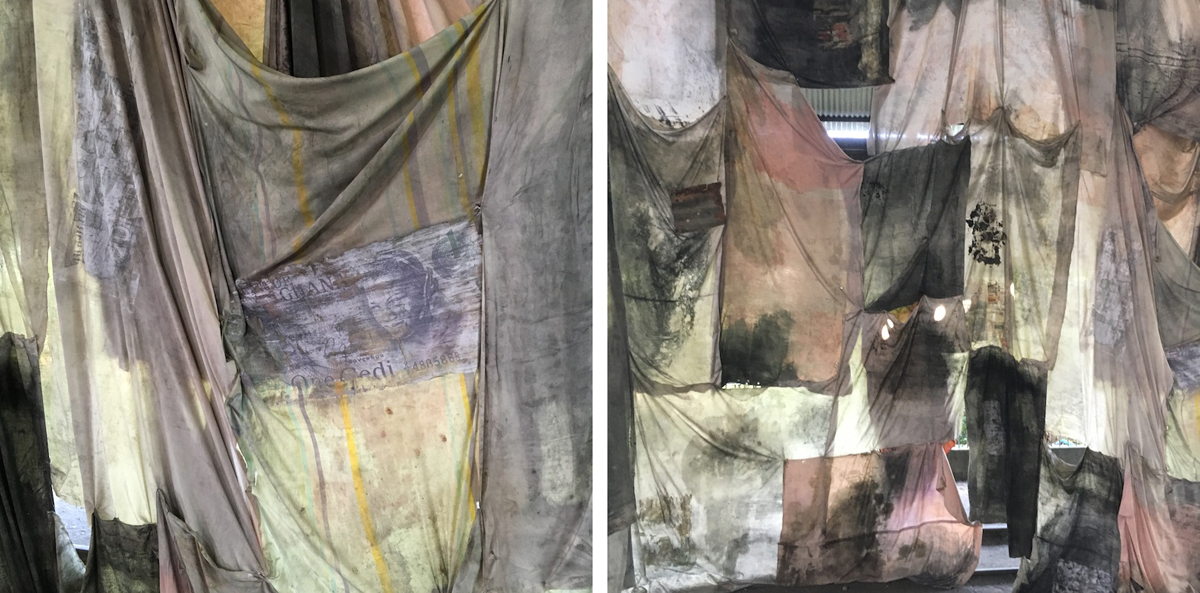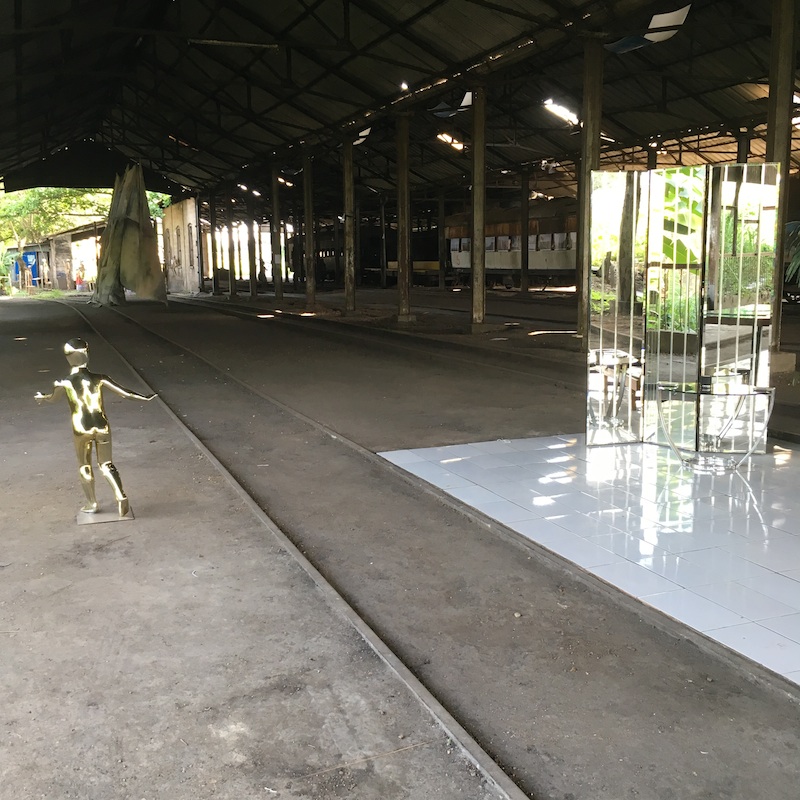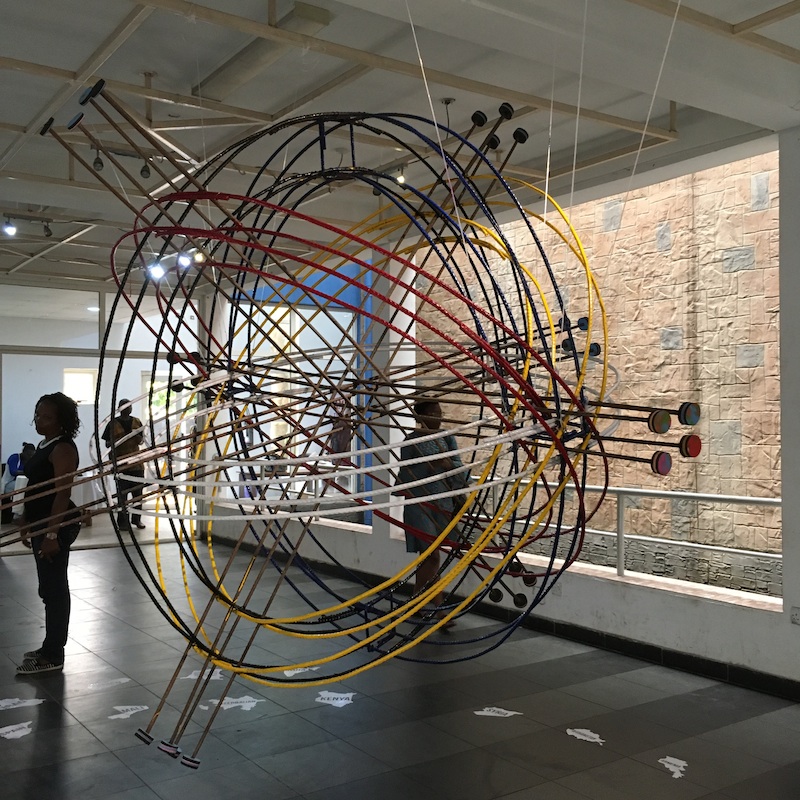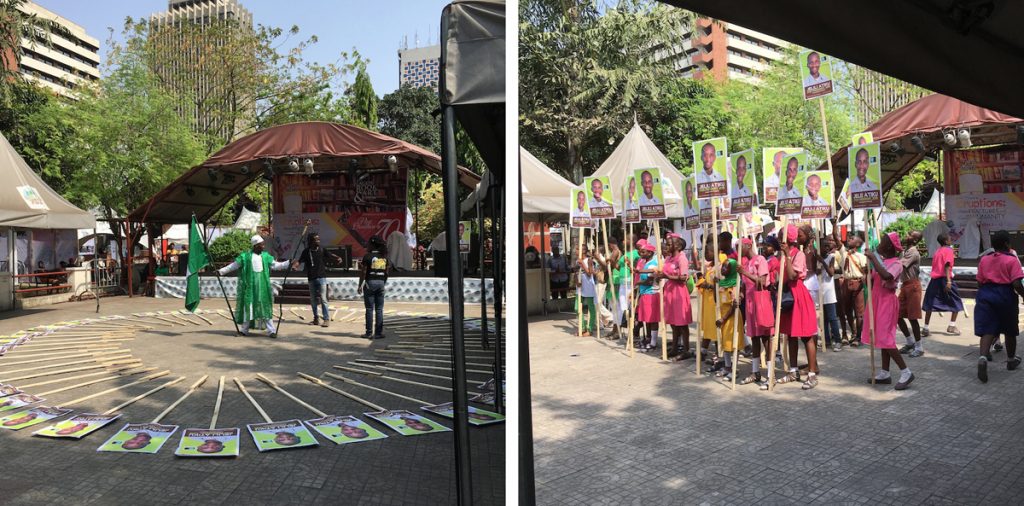While on residency in Lagos with the 2017 Iwaya Community Arts Festival, Moran Been-noon took in the Lagos art scene. She recounts here her impressions of the 1st Lagos Biennial and the 19th Lagos Book & Art Festival.
In November 2017 I travelled to Lagos, Nigeria for a month residency as part of a community arts festival in a neighbourhood on the Lagos mainland with the purpose of producing work and taking part in the Iwaya Community Arts Festival . Since I was going to be talking to locals and artists during that time and getting to know the city and its art scene first hand, I made a point of avoiding any research in advance of the residency, keeping myself as open as I could to a completely new experience that would form my impression of the place. I arrived in Lagos prepared to find a city centre, an art quarter or, like in most cities in the West, a neighbourhood where independent galleries and studios are found between coffee shops and music stores. Though it may be there somewhere, the Lagos I found did not work that way, rather it was a city of events: festivals, conferences, and launch parties filled the time between artmaking and residency activities.[1]
There were quite a few festivals happening during the month I was there, the two most notable being the 1st Lagos Biennial and the 19th Lagos Book & Art Festival; two very different vibes in fundamentally different locations. Looking at these two festivals can give an idea of the of work being done in Lagos, and how the art community deals with this immense city and its numerous facets.
Lagos Biennial 2017 is an artist-run biennial and the first art festival of its kind in Nigeria, as such it is an unusual event in the global art scene.[2] The main exhibition was located in the Old Running Shed at the Railway Compound in Ebute-Metta. Alongside the main exhibition, the programme included screenings, performances, talks, and seminars – including a performance by Jelili Atiku, one of the bigger names of Nigerian performance art. However, by mid-November, when I checked the programme before visiting the festival with the other resident artists, it seemed the festival was unofficially over and we could not find the relevant events to attend. This kind of confusion also occurred with the main exhibition: advertising of the show and the location was humble and the presentation at the Running Shed seemed to lack some of the information sheets. In their place, it was great to have one of the invigilators take us through the work, answer questions, and fill in the details.
The exhibition showed the work of 43 artists, 13 of whom were Nigerian. The curatorial selection was focused on finding artists who had some level of involvement with the subject of crisis, following the theme of Living on the Edge.[3] All politically oriented, the artworks in the shed ranged from blatant and specific political critique to looser social commentary. Most of the work was installed as site specific, with a few of the pieces successfully melding with the place in a way that made the character of the space part of the work. Three notable pieces were very strong in that sense: Adeola Olagunju’s Navigating a Dark Space, Silas Mensah’s The Noisy Wall, and Dunja Herzog’s A personal affair. Digging to remember forward.
Olagunju elected to work directly with the architecture, playing with the dark space and the very bright exterior in a piece that explored the social presentation of mental health. The artist used self-portraiture and placement of images to give the visitor a moment of intimacy. The use of the natural light and her compositions created an aesthetic reminiscent of the effect of stained glass windows in a church. There was a moment of stillness when exploring the three images, allowing one to consider conditions of judgement in the context of encountering others’ difficulties with mental health. Navigating a Dark Space may not have spoken directly about the place where it was situated, but the backdrop of dereliction and abandonment became inseparable from the experience of the piece.
In opposition to the intimate feeling of being indoors when in the shed was Mensah’s The Noisy Wall painting installation piece hanging from the roof. At first glance this work looked like a patchy shelter, mimicking those one would find roadside in some areas of Lagos. A closer look revealed the fine prints on the mix of fabrics stitched together to create a wall of rags in the middle of the shed. Particularly noticeable were the Ghanaian bank notes enlarged and printed onto several of the fabrics. This delivered a poignant stab at the familiar concept of “dwelling” versus that found in some areas in Nigeria, as well as in Ghana, where the artist is based. The Noisy Wall was composed of household materials, bed linen and drapery printed on and stained by metallic materials and mud, bound together by vegetable starch.
Inevitably this piece called to mind the article by Ruth Maclean in The Guardian about the squatters in the shed who were evicted by the owners of the space.[4] In the article the Biennial was presented as a particularly violent case of gentrification. We tentatively asked a few of the local artists (none of whom were showing work in the Biennial) who came along with us to visit the venue what they thought of the article. They rejected the claims made by the journalist, and explained that the shed is a privately owned location which is regularly loaned for projects to the local art community. According to them, the residents-squatters were requested to leave before the exhibition opened as they were actively risking the relationship between the owners and the artists. The artists were upset that the coverage of the event in the UK seemed to focus solely on the social critique. However, between Mensah’s work on contemporary urban dwellings and Eca Eps’ GRA (Government Reserved Area) which aimed to explore the privatisation of public spaces, it was clear that the subject cannot be overlooked. In the light of this article, the Biennial Advisory Board, as well as future curators, would do well to consider in advance the problematics of certain venues.
Directly exploring another public/private institution in Lagos was Dunja Herzog’s A personal affair. Digging to remember forward. The piece showed archival items and images examining the past of the Swiss United Trading Company (UTC) in Lagos, a dominant player during the colonial era.[5] Herzog, a descendant of a Swiss trader whose goods were sold by the UTC, used found objects from Basel including marble floor tiles, large mirrors and a golden mannequin and placed them so that, when browsing the archival material or looking at the reflective surfaces, the audience sees the city outside the Biennial, its tropical trees and the residents of the area walking in the shed’s vicinity.[6] As the artist intended, this work required a game of angles in order to consider the role of the West in Lagos, and vice versa. The location of the piece in the corner opposite the exhibition’s entrance allowed it to meld and integrate with the venue and its surroundings, and to play its (historical) colonial role in the material juxtaposition.
Details from Dunja Herzog’s A personal affair. Digging to remember forward resonated with many aspects of Lagos Biennial 2017. The choice of venue, both functionally and geographically, and the choice to bring together a team of Nigerian artists working on a voluntary basis were both packed with meaning which was explicitly referred to at any opportunity. While in Europe most Biennial-scale events would recruit an internationally well-known or established curator, Lagos Biennial was creatively led by a pro bono team of artists, with an up-and-coming artistic director, artist, and curator Folakunle Oshun, who defined his role in the project as “a mediator between various parties in the contemporary art scene”.[7] These creative staff choices acted as a precursor to the other decisions which set apart Lagos Biennial from its international counterparts. While most Biennial festivals host their main exhibition in art venues or in venues modified to host artwork, the Lagos Biennial 2017 team opted to use a ‘found’ location and allow the artists to respond to the venue. The abandoned shed and train cars were not modified for the exhibition, and still remained unmodified after the festival. More so, the location of the venue in Lagos defied any expectation one might have of an international, large-scale art event in Lagos. LagosPhoto, Africa Culture & Design Festival, Lagos Book & Art Festival – these major art events and more all took place in 2017 in Lagos, and all in venues on Victoria Island, the rich and Western-looking area of the city. Lagos Biennial’s main exhibition spaces were located in Lagos’ poorer, more mundane mainland area. It was a matter of identity, and part of the creative choice was to tell the story of those who lost most in times of crisis.[8]
If the Biennial was produced as a cultural demonstration, the Book & Art Festival was produced as a celebration of the power of the written word. Set up in Victoria Island’s Freedom Park, the festival included fine art, book stalls, readings, screenings, and performances. Politically themed under the title Eruptions: Global Fractures and Collective Humanism, the festival was “inspired by the convulsions in the global political and economic space… to examine the implications of all these actions on the fundamental rights and privileges of affected people, and in general, our collective humanity.”[9] At the opening, among the stalls and cocktails, we met some of Lagos’ primary culture and art producers, including the poet and critic Professor Niyi Osundare, who was the celebrated guest of honour. Osundare, who writes quite politically about Nigeria as well as global politics is a national icon and was participating in panels and readings during the festival. Unfortunately, due to constant delays in the events held over the week, it was difficult to plan ahead and catch a public talk. However, a brief introduction sent me to explore his work and gain an understanding of his importance in contemporary Nigerian culture.
The opening was also a preview of Abolore Shobayo’s piece Un-United Nations in the Freedom Park visual art gallery. Taking over the entire gallery, the exhibition consisted of a single mixed media installation pointing at the United Nations’ role in global crises. A sculpture that looked not unlike a landmine hovering over names of UN member states, this piece was a composition of political symbols and signifiers. Evidently the artist’s wish was to highlight the UN’s passive attitude towards some of its members’ political and humanitarian crises and call for a more proactive approach. Unlike some of Shobayo’s other work, such as the wooden boat he contributed to ICAF Lagos, a community arts festival held in December, which successfully used the installed found object as a representation of migration, this artwork served as a three-dimensional infographic installation, illustrating the political difficulty but with no real subtlety.
It felt as if Un-United Nations’ more direct political approach was a creative choice made by the organisers throughout the festival. Jelili Atiku’s Jelili Atiku For President 2019 is a fascinating example of this idea. Atiku, a Nigerian performance artist and activist, whose work has been included in The International Pavilion at the 2017 Venice Biennale [10] and in Lagos Biennial, is currently campaigning to become president of the Federal Republic of Nigeria in the upcoming 2019 elections as the representative of the People’s Welfare Party, running with a social democratic agenda. Atiku’s practice has long existed at the intersection between art and activism, as the artist has created performances that acted as public interventions inspired by an Orwellian view of power and politics as ends (rather than means) of political action.[11] The performance at the Book & Art Festival was produced as an organised supporters’ rally, where the candidate/performer delivered a speech laying out his agenda to the crowd. Children in their school uniforms held up Atiku’s campaign signs and asked him questions about his intentions and policies once the speech was over. This was clearly a tip-of-the-iceberg event, a glimpse into what Nigerian politics sounds and looks like. Given his activist history of resisting, including getting arrested a few weeks after being awarded The Prince Claus Awards for outstanding achievements in 2016, this ongoing public art-performance piece is certainly worth following.
Throughout the visits to the various art events, what struck me most was the powerful creative energy in Lagos, with a community of artists and makers pushing to position the city as a centre for African culture. With support given by international funds, commercial sponsors and an interested community, the city is full of individuals leading diverse art initiatives. The impression is of high aspirations and impending success, as pro bono and self-funded artists and curators received international attention in 2017. The lack of public support however, both financially and otherwise, is apparent when discussing the work with directors of the various events and encountering the completely independent spirit involved in initiating and launching any project in Lagos. It is encouraging to come across projects such as Lagos Biennial which insisted on locating itself in the heart of the city, on the mainland. This created a different idea for what a biennial project can be, led by local creative superpowers driving an international line-up with an experimental approach. Most of the artists and curators active in the production of these events in Lagos have European ties and travel between the two continents allows for cross-pollination of ideas and support. Such interchange will, hopefully, continue to enrich the Lagos independent art scene enabling it to continue its bold and blatant political art making.







